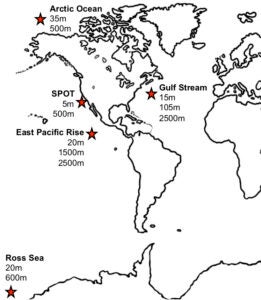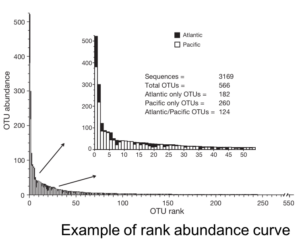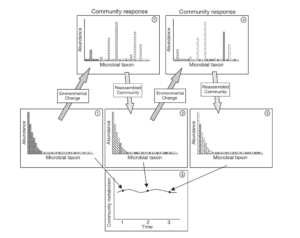The total number of species and the extent to which these populations are ubiquitously dispersed around the planet are poorly characterized features for microorganismal assemblages. Considerable debate exists regarding how many species of protists exist, and whether these species have limited geographical distributions or are globally dispersed around the planet. These questions were addressed through a survey of protistan diversity in samples collected from various locations around the world. Protistan diversity was examined using genetic markers (sequences of small subunit ribosomal RNA genes; 18S rDNA). Samples were collected from polar regions (Arctic and Antarctic), the North Atlantic and North Pacific, and from the shallow and deep ocean.
 Discovery and characterization of microbial eukaryotic diversity in these samples has provided baseline information on the diversity of microbial eukaryotic taxa across a wide spectrum of marine ecosystems. These studies also helped establish the distribution of individual species of microeukaryotes that are the subject of genomic studies and metagenomic studies that are now emerging within microbial ecology. Much of the research on protistan global diversity has focused on the importance of minute microeukaryotes (<20 µm) that are particularly difficult to identify using microscopy.
Discovery and characterization of microbial eukaryotic diversity in these samples has provided baseline information on the diversity of microbial eukaryotic taxa across a wide spectrum of marine ecosystems. These studies also helped establish the distribution of individual species of microeukaryotes that are the subject of genomic studies and metagenomic studies that are now emerging within microbial ecology. Much of the research on protistan global diversity has focused on the importance of minute microeukaryotes (<20 µm) that are particularly difficult to identify using microscopy.
 These surveys of gene diversity of natural protistan assemblages from numerous marine ecosystems have revealed a number of surprising findings. First, protistan assemblages represent a diverse array of microbial species, and genetic diversity studies of natural ecosystems have revealed unanticipated levels of diversity. Indeed, even the best methods for assessing the total number of protistan species present in a sample have proven inadequate for assaying all of the species present in a single location. Second, these studies have demonstrated that while many of the phylotypes (genetically distinct types of protists) occurring in nature are widely distributed, species that are common at one location may be exceedingly rare at other locations. Finally, a significant number of the gene signatures observed in natural samples represent ‘undescribed, uncultured’ taxa of microbial eukaryotes with unknown ecologies and distributions. As a consequence, there is great scientific interest in developing and applying cutting-edge, culture-independent, genetic approaches for determining the overall breadth and meaning of this immense diversity within various marine habitats throughout the world.
These surveys of gene diversity of natural protistan assemblages from numerous marine ecosystems have revealed a number of surprising findings. First, protistan assemblages represent a diverse array of microbial species, and genetic diversity studies of natural ecosystems have revealed unanticipated levels of diversity. Indeed, even the best methods for assessing the total number of protistan species present in a sample have proven inadequate for assaying all of the species present in a single location. Second, these studies have demonstrated that while many of the phylotypes (genetically distinct types of protists) occurring in nature are widely distributed, species that are common at one location may be exceedingly rare at other locations. Finally, a significant number of the gene signatures observed in natural samples represent ‘undescribed, uncultured’ taxa of microbial eukaryotes with unknown ecologies and distributions. As a consequence, there is great scientific interest in developing and applying cutting-edge, culture-independent, genetic approaches for determining the overall breadth and meaning of this immense diversity within various marine habitats throughout the world.
